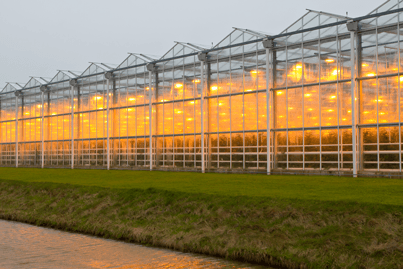The forces of population growth and climate change in addition to technological advances and numerous other factors will shape future agriculture. Yet, in the end, this means that the farms of the future will be required to produce more with less, and probably in poorer conditions. The advances which will make the farming of the future possible are currently being developed.
Plant Physiology Research
Plant physiology, how plants grow, reproduce, and develop, influences production yield and quality in a number of ways. Light is possibly the most vital environmental factor which influences plant physiology.
Plants give diverse responses to the quality, direction, quantity, and duration of light cues in their environment. They generate hormones and other secondary metabolites that influence food quality, production yield, and taste.
For successful indoor cultivation, understanding plant responses to light cues is vital. Researchers from Belgium, Denmark, and Bulgaria have been studying the influence of differing light conditions on plant physiology. Plants have photoreceptors which sense ultraviolet-A, ultraviolet-B, red and blue light. These photoreceptors can sense the quality, intensity, duration, and direction of light.
Red v. Blue Light
The number of photons utilized for photosynthesis within the 400-700 wavelength range of photosynthetically active radiation (PAR) is represented by the photosynthetic photon flux density (PPFD). Close to the surface, red and blue light are absorbed effectively, and are the most crucial wavelengths for photosynthesis.
The key plant pigment for photosynthesis, chlorophyll, absorbs both blue (420-450 nm) and red (600-7100 nm) light.
- Chlorophyll type-a has absorption peaks at 430 nm (blue) and 665 nm (red)
- Chlorophyll-b possesses absorption peaks at 453 nm (blue) and 642 nm (red)
Light absorption in chlorophyll dips to its lowest at 550 nm. (Ouzounis 2019)
As it possesses a higher frequency and thus, a shorter wavelength, blue light has more energy than red light. However, photosynthesis depends on the total number of photons absorbed and not the energy content of the individual photons. The extra energy is lost as heat in the case of blue light. In the lower efficiency in the blue range this effect is clear. (Ouzounis 2019)
Different species of plants react differently to red and blue light, and even different types of the same species of plant would thrive better in differing light conditions. Seedling plants sold in containers are often grown with insufficient light, in crowded conditions and usually have elongated hypocotyl (the stem located below the seed leaves and directly above the roots) as a result of the poor light quality.
Plants which are unnaturally tall have low fresh weight yield, and thin foliage is grown as a result of this. This elongated characteristic is especially prominent in spice plants and herbs. Due to light quality during the germination phase, dill plants in particular have fewer leaves, high elongation, and smaller leaf area.
Researchers at the Poznan University of Life Sciences, Poland examined different amounts of blue light between 10 and 15% with a constant proportion of red light and its effect on dill plants. They discovered that generally, dill plants treated with red light were higher overall and displayed elongated internodes, but the plants treated with blue light had shorter internodes and generated relatively high herb yields.
However, the plant response to blue light is extremely sensitive and is dependent not just on the proportion of blue or red light, but also the growth stage of the plant. (Frąszczak 2016)
Under high doses of blue light throughout early weeks of germination, the elongation of the hypocotyl stem structure was most suppressed, with the shortest hypocotyl length exhibited by plants grown under 50% blue light.
However, at later stages of growth, lower amounts of blue light could be enough to suppress elongation, while supplying advantages to net photosynthetic rate where the highest values were discovered in plants that were treated with blue light under 30%. (Frąszczak 2016)
Other plant species show the best growth under different conditions. For example, a 1:1 ratio of red to blue light was found to be effective for cherry tomatoes, yet a red to blue ratio of 0.9:0.1 could be better for some spinach, lettuce and radishes.
Though blue light suppressed stem elongation in lettuce and dill plants, eggplants which were grown under blue light exhibited longer stems than plants which were grown under any other color. Light may alter the expression of non-food commercial plants too. Raising the proportion of blue light to chrysanthemums and roses lead to shorter flower heights. (Frąszczak 2016)
Ultraviolet Radiation
Ultraviolet-B radiation (280-315 nm) has an increasingly negative impact on the living organisms on earth because of the depletion of the ozone layer. In addition, other than very high altitudes, ultraviolet-C radiation is absorbed in the upper atmosphere and rarely reaches the earth’s surface. Yet, that may no longer be true as in 1997, scientists recorded direct solar UV-C radiation reaching the ground in Madrid. (Katerova 2009)

Bulgarian Academy of Sciences researchers examined the effect of UV-B and UV-C exposure on three important plant hormones that regulate response to environmental stress:
- Abscisic acid (ABA)
- Indole-3-acetic acid (IAA)
- 1-aminocyclopropane-a-carboxylic acid (ACC)
These phytohormones are part of regulating developmental processes like lateral root initiation and plant growth in response to environmental cues. (Katerova 2009)
Spectral Properties of Artificial Light
Typically, greenhouses supply plants with between 16 and 20 hours of artificial light each day, at intensity ranges of 100-200 μmol٠m-2٠s-1. For many years, in indoor plant cultivation, the High-pressure Sodium (HPS) bulb has been the industry standard because of their high efficiency (1.9 μmol٠m-2٠W-1) at converting electricity into photosynthetically active radiation.
Yet, the light which comes from HPS lamps is still suboptimal, generating light mostly in the yellow and orange ranges with some red light between 550 and 650 nm. Only around 5% of the light generated by HPS bulbs is in the blue range, and there is no way to alter their spectral output.
Light Emitting Diodes (LEDs) supply light within a narrow spectrum which ranges from ultraviolet to near-infrared, permitting the manipulation of the light spectrum to instigate physiological alterations with potential enhancements to plant growth. The light distribution characteristics for LEDs are comparable or surpass their HPS counterparts, making them a substitute which is fully scalable.
Increasingly, LEDs have comparable quantum efficiency to HPS lamps, and in the instances of some new Danish and Dutch and manufactured fixtures (2.2-2.4 μmol٠m-2٠W-1), could even surpass the capability of HPS lamps. In addition, LEDs are durable, solid state light sources which provide better bulb life, reaching up to 100,000 hours compared to the average HPS lifespan of between 10,000 and 20,000 hours. (Ouzounis 2019)
Spectrometers from Avantes have been utilized to enhance LED light mixtures, plus they automatically adjust shading systems within greenhouses in order to regulate the daily light integral (DLI) which is the total amount of light received by a plant in 24 hours. Avantes has been a pioneer in the implementation of spectroscopy within greenhouse environments.
Plant Health Monitoring and Quality Assessment
In smart agriculture, one of the more usual areas of interest is achieving a non-invasive means of measuring plant quality and health. As it needs limited hardware and can be carried out at extremely high speeds (e.g., 600 spectra per second), spectroscopic diffuse reflection is perfectly suited to this application.
A good example of this method can be observed in Image 1, which shows a sensor head mounted on the top of a tractor which is pulling a fertilizer implement. This system was developed and is commercialized by Yara AG, and it measures the solar illumination and correlates this with reflection data from the crops simultaneously.
The reflected light from the crops supplies rich information about the chlorophyll content, permitting the production of a health score which then regulates the fertilizer application level in real time and maps it to GPS coordinates for future monitoring. This system gives a good example of the potential of SMART agriculture to optimize resources in order to enhance agricultural yields.
An additional important area of agricultural production where spectroscopic methods have been implemented successfully is crop quality. Researchers from the Polytechnic University of Valencia, Spain are utilizing Avantes instruments to develop a mango quality index for prediction modeling and the creation of a robotic gripper which is capable of simultaneous NIR and tactile spectroscopy measurements to establish mango ripeness and quality. (Cortes 2017)
This non-destructive technique of examining fruit quality is based on the physical and biochemical properties of mango samples. Generally, at the time of maturity, mangoes are not ready for consumption, needing a period for ripening during which many vital physical and chemical alterations happen within the fruit.
In conjunction with a fiber optic probe in direct contact with the mango skin, diffuse reflectance spectroscopy was utilized to measure any alterations in ascorbic acid, soluble solids, skin color, and water content.
For the development of this quality index, an Avantes multichannel spectroscopy system was employed. The AvaSpec-ULS2048-USB2 Starline spectrometer observed the visible range from 600-100 nm and an AvaSpec-NIR256-1.7 NIRLine spectrometer covered 900-1750 nm.
Spectroscopy for Light Characterization
For the characterization of artificial and natural light in agriculture, spectroradiometers and spectrometers are important tools. Sometimes confused with a sensor, these devices supply robust information about the quantity and quality of light which is absorbed, received, or transmitted by plants.
Conversely, a sensor is usually limited to measuring a narrow band of light wavelengths which are received in aggregate. Spectrometers are valuable tools for characterizing this composition, because of the importance of the composition of light wavelengths received by plants.
Avantes AvaSpec instruments are robust and optimized for field spectroscopy challenges. In the UV/VIS range, the AvaSpec-ULS2048CL-EVO and the AvaSpec-Mini2048CL are two of the more common candidate instruments utilized in this application. They are optimal candidates for field use because of their high-speed data acquisition, compact and robust designs, and thermal stability.
The AvaSpec-NIR256/512-1.7-EVO and AvaSpec-NIR256/512-1.7-HSC-EVO are the go-to instruments for silage and grain analysis in the field for near-infrared applications.
Resources
- Cortés, Victoria, Carlos Blanes, José Blasco, Coral Ortíz, Nuria Aleixos, Martín Mellado, Sergio Cubero, and Pau Talens. "Integration of Simultaneous Tactile Sensing and Visible and Near-infrared Reflectance Spectroscopy in a Robot Gripper for Mango Quality Assessment." Biosystems Engineering 162 (10 2017): 112-23. doi:10.1016/j.biosystemseng.2017.08.005.
- Cortés, V., C. Ortiz, N. Aleixos, J. Blasco, S. Cubero, and P. Talens. "A New Internal Quality Index for Mango and Its Prediction by External Visible and Near-infrared Reflection Spectroscopy." Postharvest Biology and Technology 118 (08 2016): 148-58. doi:10.1016/j.postharvbio.2016.04.011.
- Frąszczak, Barbara. "The Effect of Different Doses of Blue Light on the Biometric Traits and Photosynthesis of Dill Plants." Notulae Botanicae Horti Agrobotanici Cluj-Napoca 44, no. 1 (06, 2016). doi:10.15835/nbha.44.1.10212.
- Katerova, Z., S. Ivanov, E. Prinsen, H. Van Onckelen, V. Alexieva, and A. Azmi. "Low Doses of Ultraviolet-B or Ultraviolet-C Radiation Affect Phytohormones in Young Pea Plants." Biologia Plantarum 53, no. 2 (06 2009): 365-68. doi:10.1007/s10535-009-0068-1.
- Ouzounis, Theoharis, Eva Rosenqvist, and Carl-Otto Ottosen. "Spectral Effects of Artificial Light on Plant Physiology and Secondary Metabolism: A Review." HortScience 50, no. 8 (08 2015): 1128-135. doi:10.21273/hortsci.50.8.1128.

This information has been sourced, reviewed and adapted from materials provided by Avantes BV.
For more information on this source, please visit Avantes BV.